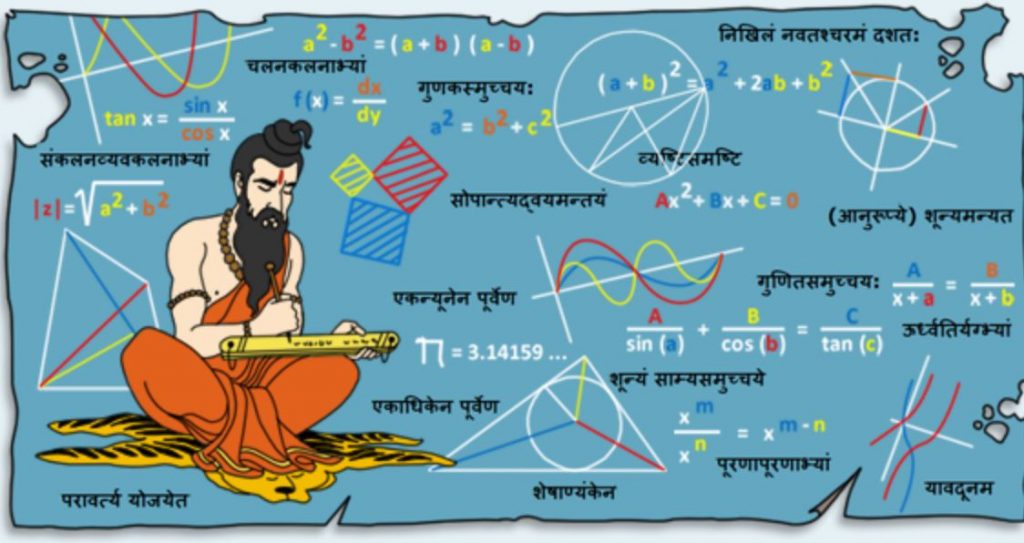India has a rich history of mathematical discoveries and inventions of Zero and decimal etc. There has been a long list of mathematicians and astronomers who made significant contributions to the development of this branch of science.
- Zero – The concept of Zero and its operation were first defined by the ancient Indian astronomer and mathematician Brahmagupta in 628 CE.
- AKS primality test – This test was first published in 2002 by three computer scientists Manindra Agrawal, Neeraj Kayal, and Nitin Saxena of IIT Kanpur. The AKS primality test is a deterministic primality-proving algorithm.
- Algebraic abbreviations – The ancient Indian mathematician Brahmagupta had begun using abbreviations for unknown variables by the 7th century. He employed abbreviations for multiple unknown variables in a complex problem. Brahmagupta further used abbreviations for square roots and cube roots.
- Basu’s theorem – The Basu’s theorem, as given by Indian statistician Debabrata Basu in 1955. This theorem states that any complete sufficient statistic is independent of any ancillary statistic.
- Brahmagupta–Fibonacci identity – Given by 7th century CE ancient Indian mathematician, Brahmagupta.
- Brahmagupta formula – Given by 7th century CE ancient Indian mathematician, Brahmagupta.
- Brahmagupta matrix – Given by 7th century CE ancient Indian mathematician, Brahmagupta.
- Brahmagupta theorem – Given by 7th century CE ancient Indian mathematician, Brahmagupta.
- Chakravala method – This is a cyclic algorithm to solve indeterminate quadratic equations is commonly attributed to Bhāskara II, (1114 CE – 1185 CE) and Jayadeva (950 CE ~ 1000 CE).
- Decimal system – This system was evolved by the ancient Indian mathematicians only.
- Fibonacci numbers – First described by Virahanka (700 CE), Gopala (1135 CE) and Hemachandra (1150 CE) by extending the 200 BCE Sanskrit prosody of Acharya Pingala.
- Finite difference interpolation – The ancient Indian mathematician Brahmgupta mentioned possibly the first instance of finite-difference interpolation around 665 CE.
- Formal system – A ormal system is essentially an axiomatic system which is an abstract structure used for inferring theorems from axioms according to a set of rules. The ancient Indian Sanskrit philologist, grammarian and scholar Panini is credited for creating the first formal system in the world.
- Hindu Number System – This number system was developed in India between the 1st to 6th centuries CE. It was the first number system using ZERO and Decimal.
- Kosambi-Karhunen-Loeve theorem – It was originally developed by Damodar Dharmananda Kosambi in 1943. This theorem is a representation of a stochastic process as an infinite linear combination of orthogonal functions, analogous to a Fourier series representation of a function on a bounded interval.
- Madhava series – Madhava of Sangamagrama (1350 – 1425 CE) defined this infinite series expression of trigonometric sine, cosine and arctangent functions, and the special case of the power series expansion of the arctangent function yielding a formula for computing π. Madava was also the founder of the founder of Kerala school of astronomy and mathematics.
- Pascal’s triangle – This was described by Varahamihira (6th century CE) and Halayudha (10th century CE) while commenting on an obscure reference by Pingala to the ‘Meru-prastaara’, which means ‘Staircase of Mount Meru’, in relation to binomial coefficients.
- Quadratic equation – Ancient Indian mathematician Shridharacharyaderived the quadratic formula used for solving quadratic equations.
- Pells equation – Indian scholar Brahmagupta (598–668 CE) was able to find integral solutions to vargaprakṛiti, around 1000 years before Pell’s time.
- Ramanujan graph – This is a regular graph ( as per Graph Theory) whose spectral gap is almost as large as possible. Such graphs are excellent spectral expanders. This was discovered by the Indian mathematician Srinivasa Ramanujan in the early 20th century.
- Ramanujan prime – This is a prime number that satisfies a result proven by Srinivasa Ramanujan in the early 20th century, related to the prime-counting function.
- Ramanujan sum – Ramanujan’s sums are used in the proof of Vinogradov’s theorem that every sufficiently large odd number is the sum of three primes. Srinivasa Ramanujan mentioned the sums in a paper published in 1918.
- Ramanujan summation – This is a method invented by the Indian mathematician Srinivasa Ramanujan in the early 20th century for assigning a value to divergent infinite series.
- Ramanujan Theta function – This generalizes the form of the Jacobi theta functions while capturing their general properties. This was also defined by the Indian mathematician Srinivasa Ramanujan in the early 20th century.
- Rolle’s theorem – Bhaskara II (1114–1185 CE) is credited with original knowledge of Rolle’s theorem. However, is named after Michel Rolle who described without sufficient proof and that was later proved by Cauchy.
- Trigonometric functions – The trigonometric functions sine and versine originated in Indian astronomy. They were first described in detail by Aryabhat in the late 5th century but possibly developed earlier in astronomical treatises like ‘Surya Siddhanta of the 3rd or 4th century. Later, the 6th-century astronomer Varahamihira discovered a few basic trigonometric formulas and identities, such as sin²(x) + cos²(x) = 1.
